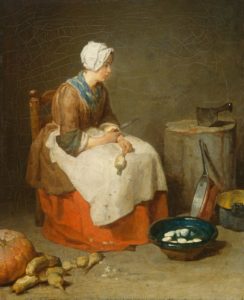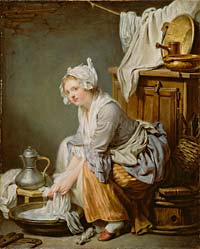
Jean Siméon Chardin, The Kitchen Maid, French, 1699 – 1779, 1738, oil on canvas, Samuel H. Kress Collection
A few days ago, a friend commented that our appliances and small machines–washers, dryers, dishwashers, lawnmowers, garbage disposals–even cars–are the modern-day equivalent to servants. I had never thought of it that way, but she’s right. In Regency England, however, people relied on manpower to run their households. Many people comment on the division of classes in those days–specifically the differences between the upper classes and the working class. However, what a lot of people don’t realize is that there was a whole social structure within the working class–especially those employed by the Big House, and house servants were even more conscious of status and rank than members of the ton.
At the top of this food chain were the housekeeper and butler. Not all houses had both, but those that did, had two leaders each with different duties. They were addressed as Mr. Lastname and Mrs. Lastname, both by their co-workers and their employers. Lower servants were normally addressed their first names. The cook was most often called Cook (unless you had a fancy French chef, in which case you stuck with strict formality). The servants called those above them Mr. Lastname, Mrs. Lastname, etc, and addressed those below them by their first names. For example, a groom would call the top footman Mr. Lastname, and would call the groom Firstname. Sometimes the family simply called the person by their job title such as John Coachman, regardless of his real name. It all depended on the individual’s personality, their relationship with the servant, the servant’s position as well as his personality, and the circumstances.
In a small country manor where most of the servants were drawn from the tenant families, they would mostly be related to each other and use names for each other that they had used since birth. A lady might call her lady’s maid Lastname if they had a formal relationship (especially if the maid was French or good enough to be called a “dresser” or “lady’s” maid rather than simply a maid). If this personal maid had been serving her since she was a child, then they might have developed a friendlier relationship. The same goes for a gentleman and his valet.
Author Arietta Richmond has a thorough list of household servants on her post on Historical Hussies. I cannot improve on it, so I will simply quote her:
Butler
The senior servant in the house, responsible for oversight of all other male servants (except in some cases, where a Lord might have a steward who was responsible for all of their estates, in which case the Butler also answered to the Steward, as the Butler was only for a single house). Butlers also were not necessarily responsible for managing tutors, who might come in each day just to teach. Responsible for making everything run smoothly, for the security of the silverware and other valuables, and for the quality of service.
Housekeeper
The senior female servant in the House, responsible for oversight of all other female staff (except for the Companion or Governess, if there is one). Responsible for ensuring that the linens, draperies etc are maintained in good order, that the rooms are cleaned as needed, that the items needed for the kitchens (as specified by the Cook) are available, and that the female servants are cared for and protected from abuse.
Cook / Chef
Responsible for the kitchen for that establishment. Manages the scullery maids and any kitchen boys. Responsible for food ordering, and for planning menus, in consultation with the mistress of the house and the housekeeper. Also manages the storage of food and avoids waste. In a big house, there may be second cooks, who answer to the senior cook.
Scullery maids
Work in the kitchen, under the Cook’s direction. Scrub benches, tables, pots and keep things clean, also may be called upon to cut up food and help with other prep work.
Kitchen Boys
Do the dirty work in the kitchens – keep the fires going, cart coal or wood, cart away the rubbish, take the food scraps out to the compost heap. Turn the spit if there is a spit to cook whole animals, carry water where there is no running water.
 House maids
House maids
Responsible for keeping the house clean and tidy. Each maid will be allocated certain rooms to keep clean – dust and mess free, with everything in its place, and making sure that there is always coal in the coal scuttle beside each fire place, ready to go. The larger the house, and the wealthier the owner, the smaller number of rooms that each maid will likely have to look after, and the more maids there will be.
Ladies maids
Generally, each lady living in the house would have a dedicated Lady’s maid, to help her dress, to do her hair, and generally to look after her in any way that was needed. Sometimes, two sisters might share a maid. The maid was expected to have sewing / clothing repair skills, cleaning skills, hairdressing skills, skill with cosmetics and more.
The Lady’s maid was the top of the hierarchy of maids, with greater privileges, including often receiving her mistresses cast off dresses – which, even when they were ‘too old and unfashionable’ for the Lady, could easily be reworked into higher quality dresses than the maid might ever have otherwise.
Footmen
Footmen were the ubiquitous method of getting anything done. They might be tasked with staying in the foyer, ready to open the door, or might each have a section of the house where they simply waited in the halls, ready to run errands or do whatever was needed. There was a hierarchy here as well – some tasks were more desirable than others. Footmen might also accompany a lady when she went shopping, ready to carry her parcels. Pretty much any time that someone pulled the bell rope to summon a servant to get something done, the one who answered was a footman, even if the task then required action by someone else.
Nanny
If the household had young children, there was usually a nanny. The Nanny was the senior childcare servant and might have nursery maids to help her – the more children, the more nursery maids. The nanny was also usually responsible for the children’s first, very basic, education – in manners, and in simple reading and numbers.
Nursery maid
Nursery maids did the tedious bits of childcare – from changing nappies, to being the one up at all hours of the night, to providing entertainment for teething children. They took children out for walks in the park (note, early baby carriages barely existed yet, so often they carried the children), and amused the children. They also had to deal with washing all of those nappies….
Valet
The Valet, like the Lady’s maid, was a role with status. The valet was the gentleman’s personal servant, responsible for helping him dress, caring for his clothes, shaving him, polishing his boots and more. A good valet could tie a perfect cravat in multiple styles and could dress a man’s hair in the fashion of the day. He was also likely to receive the gentleman’s cast off clothes, and was expected to be very discreet about the gentleman’s day to day affairs, which he was almost always aware of.
Valet
The Valet, like the Lady’s maid, was a role with status. The valet was the gentleman’s personal servant, responsible for helping him dress, caring for his clothes, shaving him, polishing his boots and more. A good valet could tie a perfect cravat in multiple styles and could dress a man’s hair in the fashion of the day. He was also likely to receive the gentleman’s cast off clothes, and was expected to be very discreet about the gentleman’s day to day affairs, which he was almost always aware of.
Governess
A Governess was employed to teach younger children – usually girls, but sometimes also very young boys. A Governess was an odd position, hallway between a normal servant, and a gently born lady. Often, women of the upper classes, whose families had fallen on hard times, would take employment as a governess. It was regarded as one of the only acceptable roles for a well born lady, if she had to work. The governess taught young girls manners, ladylike skills (painting, music, singing, dancing, languages and more) and prepared them for their role in society.
Companion
A Companion was employed to keep an older woman, or a single woman, company – this provided a layer of propriety, as well as giving an older widow (for example) someone to talk to, in their daily life. Companions, like governesses, were in that grey area between servant and the nobly born. They were often from good families fallen on hard times, or they were distant cousins from the poor side of the family.
Tutor
A Tutor was employed to teach boys, before they reached the age where they were sent off to boarding schools. The Tutor taught languages, maths, science and potentially other subjects which were regarded as suitable for boys. Like governesses, tutors might be of gentle birth, but from a poorer family, but they might also be from a commoner family, but be a man who had done well for himself and become learned. They might live with the family, or come in each day to teach, and live elsewhere.
Smaller houses would not have had all these servants. They might simply have a maid-of-all work, or two. It all depended on the wealth and status of the family.
The Hierarchy of Servants posted first on http://donnahatchnovels.tumblr.com/
No comments:
Post a Comment